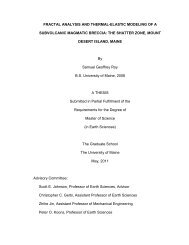Jumars, P.A. - University of Maine
Jumars, P.A. - University of Maine
Jumars, P.A. - University of Maine
Create successful ePaper yourself
Turn your PDF publications into a flip-book with our unique Google optimized e-Paper software.
NEW SPECIES OF NORTH PACIFIC DORVILLEID POLYCHAETES 103<br />
SYSTEMATICS OF DORVILLEIDAE<br />
Family Dorvilleidae Chamberlin, 1919<br />
Description . The rounded prostomium nearly always bears a pair <strong>of</strong><br />
dorsolateral antennae and a pair <strong>of</strong> lateral palps . Antennae and palps may be<br />
simple or may carry one or more articles . Rarely, either the antennae, palps, or<br />
even both may be absent . Up to four circular or reniform eyes may be present .<br />
Nuchal organs may occur as a pair <strong>of</strong> indistinct pouches at the postectal<br />
prostomial margin or may include a median papilla posterior to the antennae .<br />
Two apodous rings, not true segments (Akesson, 1967), are present between<br />
the prostomium and the first setiger .<br />
Parapodia are uniramous pr subbiramous . Neuropodia are nearly always well<br />
developed and bear smooth or denticulate capillary setae above the principal<br />
acicula and heterogomph setae below . In addition, the supra-acicular bundle<br />
may contain furcate setae . When dorsal and ventral cirri occur, they are<br />
digitate, ellipsoid, or papilliform .<br />
Dark, chitinized mandibles are always present . They are anteriorly flared and<br />
are most <strong>of</strong>ten denticulate . Maxillary structures consist <strong>of</strong> a pair <strong>of</strong> carriers and<br />
four rows <strong>of</strong> denticles with accompanying basal plates . These components are<br />
variously modified, lost, or fused, in age-specific and species-specific manners .<br />
Remarks . As can be seen from a perusal <strong>of</strong> Pettibone's (1961) revision, the<br />
dorvilleids have suffered a plethora <strong>of</strong> nomenclatural difficulties . As she shows,<br />
most <strong>of</strong> these difficulties have been solved according to the international Code<br />
<strong>of</strong> Zoological Nomenclature (ICZN ; Stoll & Melville, 1961), but one has been<br />
passed over. An historical review may be <strong>of</strong> some help in resolving the<br />
difficulty .<br />
In 1855, Grube described Staurocephalus rubrovittatus (type-species by<br />
monotypy) . This species lacks furcate setae . In 1866, Parfitt described<br />
Dorvillea lobata. In 1900, Verill realized Staurocephalus was preoccupied, and<br />
he proposed Stauronereis as a replacement name . At the same time, he<br />
proposed that Nereis Rudolphi delle Chiaje, 1828, a species with furcate setae,<br />
become the type-species <strong>of</strong> Stauronereis . Article 67(i) <strong>of</strong> the ICZN retroactively<br />
forbids changing <strong>of</strong> the type-species when a generic name is replaced .<br />
Stauronereis Verrill thus becomes invalid .<br />
In 1910, McIntosh synonymized Dorvillea lobata and Staurocephalus<br />
rubrovittatus . Dorvillea thus became the valid name for the genus typified by<br />
Staurocephalus rubrovittatus Grube .<br />
The group <strong>of</strong> dorvilleids typified by Nereis Rudolphi delle Chiaje is hence<br />
left without a name . Schistomeringos, Greek for "split bristle," is proposed . It<br />
is feminine in gender and refers to the characteristic furcate setae <strong>of</strong> the genus .<br />
The diagnosis very closely parallels that <strong>of</strong> Stauronereis sensu Pettibone (1961) .<br />
Genus Schistomeringos nom . nov .<br />
Type-species. Nereis Rudolphi delle Chiaje, 1828 .<br />
Diagnosis . The prostomium diverges from a hemispherical shape by being<br />
slightly compressed dorsoventrally . Antennae and palps are well developed and<br />
are <strong>of</strong> approximately equal lengths . The latter are biarticulate and the former<br />
are multiarticulate . Dorsal and ventral cirri are present, the former being
















